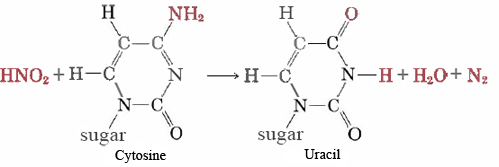Information Storage in Genetics
- Page ID
- 50933
If the central dogma of molecular genetics is correct and the DNA in the cell nucleus contains all the information necessary for proper cell functioning, it follows that any errors in replication, transcription, or translation will result in some malfunction of the cell. Errors during transcription and translation will usually affect only one or a few protein molecules. Consequently they are not as serious as errors during replication or direct modification of DNA’s sequence of bases. The latter will be transmitted from the damaged cell to the progeny by subsequent replications and thus are longer lasting. In multicellular organisms this is most deleterious in the sex or germinal cells which combine to produce a new organism.
A change in the base sequence of DNA is called a mutation. Any change it produces in an organism’s macroscopic characteristics will be tested by the process of natural selection. Occasionally such a change is favorable: The organism will be better adapted to its environment, and the mutation will become a legacy to subsequent generations. More often a mutation results in a detrimental characteristic, and its host organism dies. Nevertheless, without some small rate of mutation the characteristics of human and other populations would remain fixed. With no means of adaptation to changed environmental conditions such populations would eventually die off.
Knowledge of the function of DNA in the flow of genetic information provides some clues as to what substances or conditions may contribute to the occurrence of mutations. For example, nitrous acid can react directly with DNA, converting cytosine to uracil:

This obviously alters the message of the genetic code. Aromatic hydrocarbons such as β-naphthylamine

have flat structures which can squeeze between adjacent base pairs in DNA. This causes the double helix to unwind slightly, and may cause errors during replication or transcription.
Some molecules, as well as high-energy radiation, can dissociate the covalent bonds holding the DNA backbone together, breaking both strands of the double helix. Such breaks can be repaired by appropriate enzymes, but sometimes the strands are put back together the wrong way or an entire section of the molecule can be lost. Since too high a level of mutation will result in numerous deaths of maladapted individuals, dispersal into the environment of agents such as those described above should be avoided. In some cases what was once a useful mutation may become detrimental and even cause what is known as molecular disease. A good example of this is sickle-cell anemia, a disease in which the red blood cells assume a crescent shape and tend to precipitate to form clots when deoxygenated in the small blood vessels. This impairs circulation and results in premature death of those afflicted. It has been determined that the sickle cells are the result of a mutation in the gene responsible for synthesis of hemoglobin. The change is quite small—only one position out of a chain of 146 amino acids is affected. However, that one mistake involves substitution of glutamic acid (negative, hydrophilic) for valine (hydrophobic). The negative charge on the glutamic acid side chain is enough to disrupt the tertiary and quaternary structure of hemoglobin and to impair its oxygen-carrying function. Thus the cause of the disease is a very small error in the molecular structure of DNA and hence protein.
The sickle cell trait is apparently the result of a chance mutation many thousands of years ago. Since that time it has been transferred from one generation to another by DNA replication. One might have expected this disease to be eliminated by natural selection, but it turns out that the abnormal blood cells are also resistant to a malarial parasite. Even their impaired oxygen-carrying ability was preferable to an invasion by malaria. Consequently the gene which produces sickle cells was somewhat favorable in tropical regions where malaria abounded. Sickle-cell anemia is especially prevalent among black persons, most of whose ancestors lived in the tropics until a few generations ago. Since human medicine can now control malaria, the presence of the DNA base sequence which produces abnormal hemoglobin is no longer of value.
From CoreChem: 20.18: Information Storage
Contributors and Attributions
Ed Vitz (Kutztown University), John W. Moore (UW-Madison), Justin Shorb (Hope College), Xavier Prat-Resina (University of Minnesota Rochester), Tim Wendorff, and Adam Hahn.


